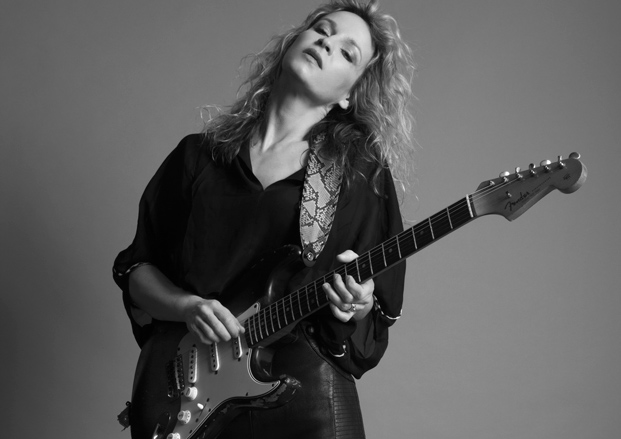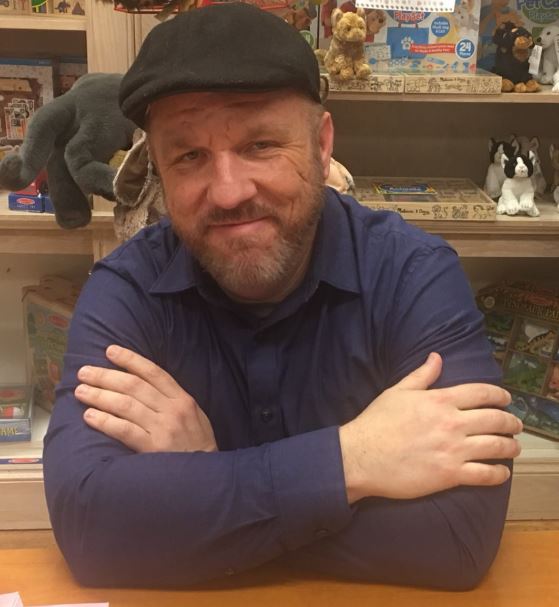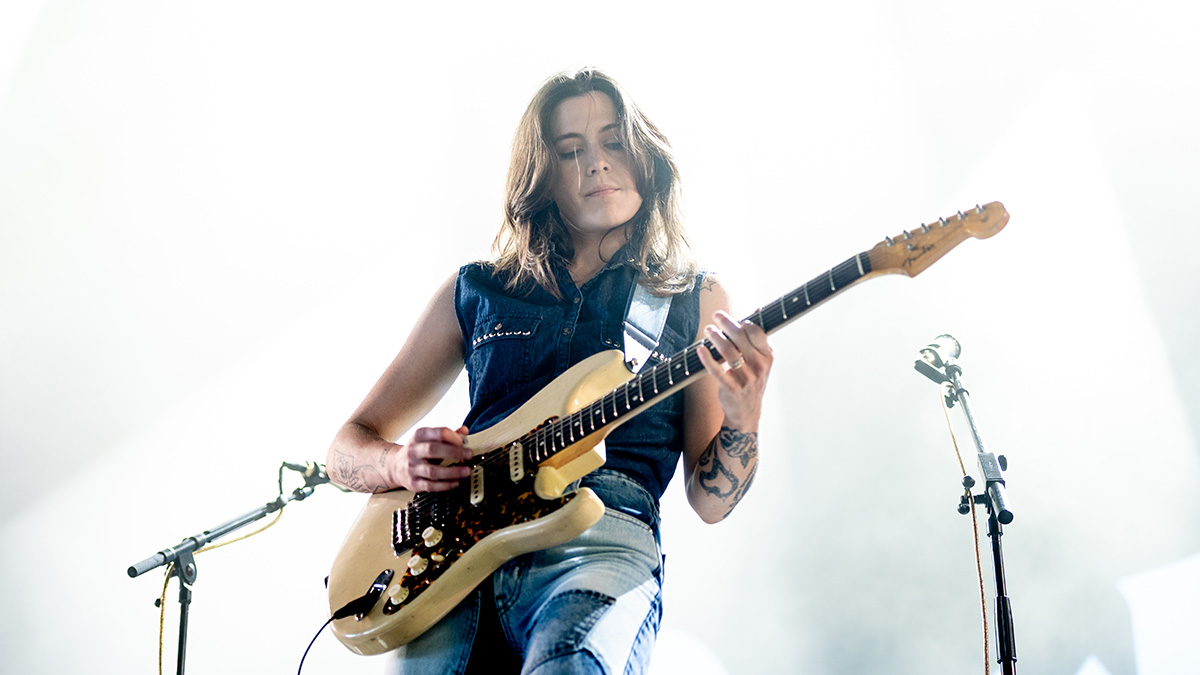Ana Popovic Previews Her New Three-Album Project and the Experience Hendrix Tour

On May 20, guitarist Ana Popovic—who, as we know by now, can play the hell out of the blues—will unleash Trilogy, an epic new three-album set.
The new package is unique because it will highlight Popovic's tasteful shredding and soulful voice in three different elements: blues, jazz and funk.
Growing up in Serbia under the Milosovic regime, Popovic had to fight for her right to be blue. A battle in which she has obviously triumphed. She’s performed at blues and jazz festivals worldwide, sharing the stage with a veritable who’s who of blues legends.
We recently caught up with Popovic to discuss the Trilogy project—which includes guest appearances by Joe Bonamassa, Robert Randolph and more—plus her role on the Experience Hendrix tour, her gear and more.
How did the idea for Trilogy begin?
I’ve actually had this idea for a few years. There’s always been a little bit of everything on my records: blues, jazz and funk. Fans had always been coming up and telling me how much they loved my sound. They’d tell me they would often make compilation playlists from all of my records. One would say, “I made a set of blues songs for me and another set of jazz songs for my wife.” I thought that was an interesting idea.
Then last year, we had a big incident where our touring van was stolen with all of our gear in it. We were in the middle of a tour and it was through the tremendous support of the fans that we were able to get back on the road. I was so touched by how much they had helped us that I wanted to do something in return. I wanted everyone to have a lot of music but not have to buy three records. I wanted to approach the music from different sides. I’m giving three different sounds of my music to them: three different producers, three different bands and three different recording studios. As a guitar player, that was the biggest goal.
Get The Pick Newsletter
All the latest guitar news, interviews, lessons, reviews, deals and more, direct to your inbox!
How did you approach writing for this project?
The first official demos for the project began in March of last year. Some of ideas for this album are from a long time ago, because I never give up on the song. I bring ideas to every session, and if it doesn’t match with the band that’s recording it, I’ll leave it. But I’ll never give up on it. I’m always planning and figuring out how they should be done and would always make notes to go with them—Is this jazz? Is it blues? What drummers or producers can I use? Everything was well thought out, and I gave myself a lot of time.
Is there a certain vibe you look for when you write songs?
Lately, I’ve been into writing melodies first, but I’m also very serious about lyrics. Because if you’ve got the right lyrics, then there’s already a good pulse and rhythm to it. I’ve also recently gone back to scatting and not really having any idea of where it the song is going to go. There’s something cool and unconscious about scatting and writing down bits and pieces of words. I never throw anything away because there’s always good stuff.
Let’s talk about a few tracks from Trilogy. What can you tell me about your version of “You Got the Love”?
That’s a Chaka Khan thing. She’s such a great singer, and this was something I’ve wanted to do for a long time. I’ve always heard it as a rock song and wanted to approach it that way. It went through quite a few changes. I started out with a band but ended up keeping just the drums and putting it together to fit that Lenny Kravitz/straight-to-the-point beat. I built the track from there.
“She’s a Doorman”
It’s a great song and a true story. That was a long time ago when we were establishing ourselves in the States and played this crazy place in the middle of nowhere. The place was falling apart and the woman there was working it. I wrote the lyrics the next evening, and it’s just what I describe in the song. She was a doorman and an owner, a soundman and a microwave chef. She was hardcore and a really nice lady. It has that driving horn section and guitar riff. It’s one of the coolest tracks on the project!
What can you tell me about working with Joe Bonamassa on this project?
Incredible. I gave Joe the option to choose and he picked a very sexy track called “Train," which is about a one-night stand. It’s a huge and imaginative song. I wanted to make it so real that it makes you feel like a theater play.
You’re also part of the Experience Hendrix Tour for the third time. What is that experience like?
It’s an honor and privilege to be a part of it. It’s full concentration and brining your “A” game every night. You’ve got guys like Zakk Wylde going through the audience and burning the place down. That adrenaline and rush really gives me a kick. The other cool thing is that it’s a guitar player audience. You’ve got Eric Johnson and Buddy Guy’s people there as well as Dweezil Zappa’s fans. So you’ve got to entertain a whole lot of different guitar players. It’s an incredible challenge, and I love challenges.
What’s your setup like these days?
The rock and blues has always been a Strat, but for the jazz solos I started using the Gibson ES-175, which was new for me. I’ve also got a really cool Blackface Super Reverb that I put together with an old Bassman and my Mesa Boogie Mark IV amps. That’s my presence. Mesa for all of the modern and deep stuff; Bassman for the bottom and the Blackface Super for all of the reverb and sustain.
What’s the best bit of advice you can give to someone who wants to play the blues?
There are many secrets, but I think the main thing is you’ve really got to really go deep.
It’s the same whenever I hear Buddy Guy or Ronnie Earl and how they phrase. You have to go back to the roots and really dig deep. You might think the way they phrase those three lines is just random, but it’s very well thought out. But they don’t even think about it. It’s something that’s deep inside them. So listen to guys like Buddy Guy, Albert King and Ronnie Earl, and then switch it up.
Then put on some George Benson and Robben Ford, but don’t forget about the other things you’ve learned. It’s all about phrasing and where you put the notes. It’s got to be around the 12-bar blues with the I-IV-V change. Then the only thing you have to do is phrase them differently so that it stands out as your own.
For more information, visit www.anapopovic.com.
James Wood is a writer, musician and self-proclaimed metalhead who maintains his own website, GoJimmyGo.net. His articles and interviews are written on a variety of topics with passion and humor. You can follow him on Twitter @JimEWood.
James is a guitarist and freelance writer who's interviewed some of the biggest names in music. He is the author of four books and his writing credits include work for Guitar World, AXS and Yahoo! as well as for his hometown newspaper where he writes on a variety of topics with both passion and humor. As a guitarist, he's performed everywhere from local bars and nightclubs to some of the biggest stages in front of thousands of music fans.











